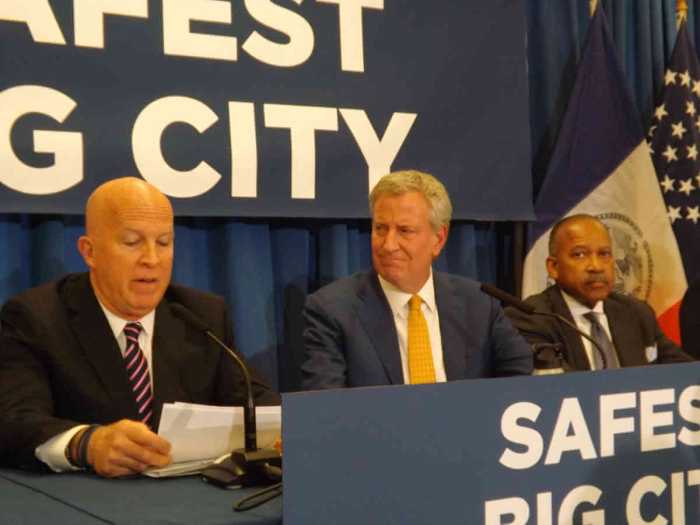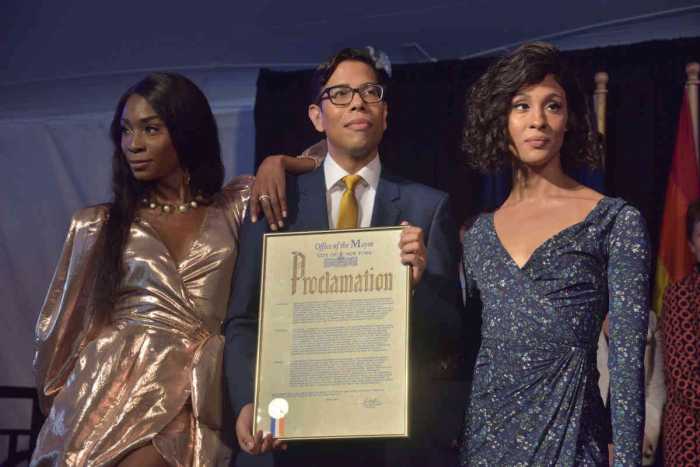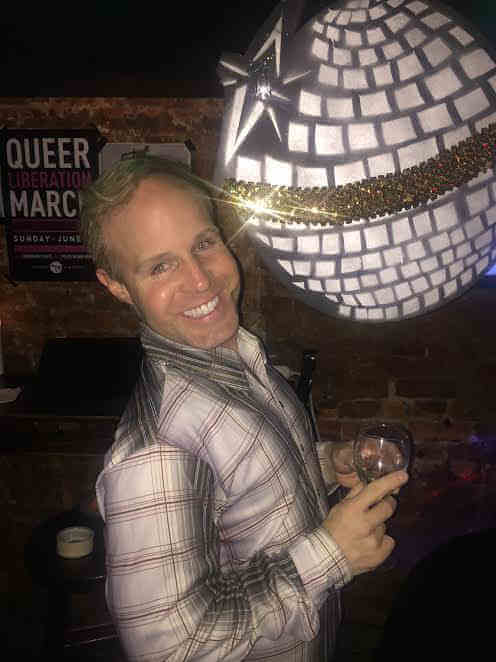First Lady Chirlane McCray at last week’s NYC Unity Project announcement she co-hosted with City Council Speaker Corey Johnson. | NYC MEDIA
In a highly choreographed event in City Hall’s Blue Room on May 30, First Lady Chirlane McCray and City Council Speaker Corey Johnson announced a three-year, $9.5 million investment in the de Blasio administration’s ongoing NYC Unity Project focused on the needs of LGBTQ youth.
The initiatives to be funded include the expansion of three youth drop-in centers’ hours to 24/7, a variety of efforts aimed at building greater family acceptance of queer youth, a confidential foster youth population survey that will include questions about sexual orientation and gender identity and expression, and two new sites in Harlem and Central Brooklyn to facilitate PrEP access among adolescents.
And for the first time, the city will fund shelter beds for homeless young people 21 to 24 years old in facilities that are LGBTQ-affirming and supportive. In what the administration described as its “initial investment,” the budget for the fiscal year beginning on July 1 will include $1 million, which will fund 20 shelter beds for one year.
City will house 21 to 24-year-olds, but advocates question dollar amount, priorities
Despite the fact that providing shelter options for this age cohort separate from the adult shelter system — which for many young people is dangerous and unwelcoming — has been a long sought goal of youth advocates, the allocation falls well below what both they and Speaker Johnson himself have been calling for. While Johnson’s statements at the event were laudatory toward the administration and McCray, others who have been promoting the issue — including some of the youth who appeared as part of last week’s City Hall program — faulted the announcement both for the shortfall in beds being funded and for the priorities that did not receive attention in the $9.5 million allocation.
In early March, the City Council unanimously approved legislation mandating that the city’s Department of Youth and Community Development implement shelter services for the 21-24 age range. The Council action followed a dramatic appearance by Johnson at a February 13 Youth Services Committee hearing, where DYCD officials offered testimony about the cost of providing such shelter. In response, the speaker said, “I don’t really care what the amount of money is… when it comes to getting the requisite number of beds to homeless young people, we have to come up with the money. If it’s $4 million, if it’s $7 million, if it’s $8 million, we have to come up with the money. So this Council will continue to push for whatever that amount of money is to expand those services.”
On April 10, the Council, in its official response to de Blasio’s preliminary budget, called for a $10.5 million increase in the DYCD budget to provide, among other things, “100 more beds specifically for homeless young adults aged 21-24.” The 100 beds the Council called for would have cost about $5 million versus the $1 million the administration agreed to.
Still, Johnson, at the May 30 event, struck an upbeat, even emotional tone. Standing in front of young people wearing NYC Unity Project T-shirts, the speaker recalled, during the previous mayoral administration, “standing on the steps [of City Hall] begging to just keep the funding we had.” In contrast, the commitment shown by de Blasio and McCray is “unbelievably moving and affirming to these young people, I believe, and to me.”
Advocates, however, while careful to note the progress demonstrated by the number of city-funded beds for homeless youth tripling to more than 750 during de Blasio’s first term, voiced impatience that only $1 million is going toward the new 21 to 24-year-old initiative and raised other questions about the priorities that went into last week’s announcement.
In an email message, Jamie Powlovich, executive director of the Coalition for Homeless Youth (CHY), praised both Johnson and McCray for their commitment to addressing homeless youth needs, but added that the $1 million “will only fund less than two dozen new beds, and falls short of the CHY FY19 ask of $4.8M that would more adequately meet the needs of older youth by bringing online 100 additional beds.”
Carl Siciliano, founder and executive director of the Ali Forney Center, also expressed gratitude but said the plan is “long overdue,” and then added, “We have over 100 21 to 24-year-olds on our waiting list right now. I urge the city to add at least 100 beds in the coming budget.” He pointed out that more than 20 beds — funded privately — already serve the 21 to 24-year-old population, so it is possible that the new city dollars will not create any new shelter opportunities but simply pay for existing ones in a different way.
Siciliano also questioned whether money going toward family acceptance programs — important as they may be — might be better spent on beds, especially since many of the homeless youth with a history of family rejection that his group encounters come to New York from other parts of the nation or from the Caribbean. VOCAL-NY’s Jason Walker, who with Janae’ Sumter, facilitates Queerocracy, a grassroots youth advocacy and leadership initiative, echoed that assessment. He added that even among those homeless youth who grew up in New York but left their homes due to family trauma, poverty and mental health and drug use issues play as big or bigger a factor than simple lack of family acceptance.
“Homeless kids need housing,” Siciliano said. “A response to their homelessness needs to be centered on their housing. I am concerned that so much of that response is on ancillary things. I wonder how much money was spent on the subway visibility campaign to make homeless LGBTQ youth more visible. In the years I’ve been working on this issue, they have been visible as hell on the subways because they’ve needed the subways for shelter.”
Beth Hofmeister, a staff attorney at the Legal Aid Society’s Homeless Rights Project, said that without taking anything away from the other interventions McCray championed last week, “I agree 100 percent that by definition the youth you are talking about, they are homeless. This is about a fundamental human right.” Acknowledging that it is not clear exactly how many beds are needed to shelter homeless youth under 25, she added, “We are definitely not there yet.”
Walker spoke in greatest detail about what he and youth at Queerocracy, a number of whom stood on the stage last week behind McCray and Johnson, saw as lacking in the $9.5 million announcement. In a memo to McCray’s staff outlining their concerns, they noted that only 20 beds — rather than 100 — are being funded; that the 15 housing placement specialists the Council has called for are not being funded; that the Council mandate that youth no longer be forced out of youth shelters at 21, which takes effect next January, was not immediately implemented; and that no youth employment initiative was part of the package.
Perhaps most damning is Queerocracy’s conclusion that its members — some of whom sit on the youth advisory board of the New York City Coalition on the Continuum of Care, which brings together a broad range of government, non-profit, and consumer stakeholders in fighting homelessness — “were not meaningfully engaged” in developing the NYC Unity Project priorities announced last week.
Queerocracy and VOCAL-NY hope to set up a roundtable with McCray and other administration officials soon to discuss their concerns.



































